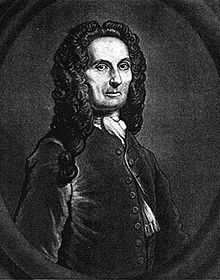Abraham de Moivre
Abraham de Moivre (born May 26, 1667 in Vitry-le-François , † November 27, 1754 in London ) was a French mathematician , best known for Moivre's theorem.
life and work
De Moivre attended the Protestant school in Sedan from 1678 to 1681 , studied logic and mathematics in Saumur from 1682 to 1684 and took private lessons in Paris with Jacques Ozanam in 1684 . After the Edict of Revocation in 1685 , he was held in an abbey in Paris to persuade him to convert . On April 27, 1688 he was released and fled to England .
He made his way as a private tutor, studied and mastered Newton's Principia Mathematica and published from 1695 on work on Newton's Fluxions method of calculus , where he made the acquaintance of Edmond Halley (Secretary of the Royal Society) and Isaac Newton . Later he was a close friend of Newton and discussed with him daily at times in his house or in the coffee house where he used to hang out. On November 30, 1697 he was elected a member ( Fellow ) of the Royal Society . His attempts to get a professorship on the mainland (where Gottfried Wilhelm Leibniz stood up for him) failed, as did in England (despite the advocacy of Newton and Halley). De Moivre's life was poor.
From 1708 onwards, following Pierre Rémond de Montmort (with whom he got into a priority dispute) and Christian Huygens, he was primarily concerned with investigations into probability theory based on gambling calculations , from which The Doctrine of Chances - a method for calculating the probabilities, published in 1718 of events in play emerged . He had published a first Latin version in 1711 in the Transactions of the Royal Society ( De Mensura sortis ). After the discovery of the limit theorem for binomial distributions (1733), he published a second edition of his doctrine in 1738 . In 1756 a third edition appeared posthumously. The second edition of the Doctrine also contained de Moivre's investigations into mortality and pension problems, which Edmond Halley had already examined for applications in life insurance and about which de Moivre published a paper in 1724 (Annuities upon Lives), which he incorporated into the new edition. The book was one of the most important preliminary stages for the textbook of probability theory by Pierre Simon Laplace , who summarized the theory at the end of the 18th century and raised it to a new level.
In Miscellanea analytica de Moivre presented his theory of recurrent series. This work, published in 1730, gives an overview of de Moivre's work in analysis together with the applications of probability and astronomy . Here the Stirling formula is found for the first time in its asymptotic approximation of the binomial distribution by the normal distribution . He is also a solution to the angular pitch problem, bypassing imaginary sizes an equivalent of the eponymous "De Moivre's formula" theorem is. However, he published this sentence in a paper from 1722. He wrote in a paper from 1698 in the Philosophical Transactions of the Royal Society that he had the formula from Newton, who knew it as early as 1676, and for solving cubic equations according to Cardano -Formula used - a formula for square root extraction in complex numbers also follows from the formula . De Moivre never wrote out the formula explicitly, Euler didn't do that until 1748, but he used it in his work. He also incorporated parts of the Miscellanea analytica into the second edition of his Doctrines of Chance.
De Moivre became a member of the Royal Prussian Academy of Sciences in 1735 , and in 1754 - five months before his death - the Académie des Sciences honored him for his achievements as a mathematician with membership.
The asteroid (28729) Moivre was named after him.
literature
- A. de Moivre: The Doctrine of Chances: Or, A Method of Calculating the Probability of Events in Play. Printed by W. Pearson, for the author, London 1718, ( digitized ).
- Agnes M. Clerke: Moivre, Abraham de . In: Sidney Lee (Ed.): Dictionary of National Biography . Volume 38: Milman - More. , MacMillan & Co, Smith, Elder & Co., New York City / London 1894, pp. 116 - 117 (English).
- Helen M. Walker: Abraham De Moivre. In: Scripta Mathematica , Volume 2, 1934, ZDB -ID 280766-x , pp. 316-333.
- Ivo Schneider : The mathematician Abraham De Moivre (1667–1754). In: Archive for History of Exact Sciences , Volume 5, No. 3/4, 1968, pp. 177-317, doi: 10.1007 / BF00411630 .
- David R. Bellhouse: Abraham de Moivre. Setting the stage for classical probability and its applications. CRC Press, Taylor & Francis, Boca Raton FL, et al. a. 2011, ISBN 978-1-56881-349-3 .
Web links
- John J. O'Connor, Edmund F. Robertson : Abraham de Moivre. In: MacTutor History of Mathematics archive .
- Entry for Moivre, Abraham de (1667-1754) in the Archives of the Royal Society , London
- Abraham de Moivre (1667-1754). Spektrum.de, May 1, 2012
Individual evidence
- ↑ Nahin: An Imaginary Tale . Princeton University Press, 1998, p. 56
- ↑ For example Reinhold Remmert: Complex numbers . In: Ebbinghaus (Ed.): Numbers . Springer 1983, p. 75. In 1707 he published numerical examples indicating knowledge of them, and after a publication in 1730 he seemed to know the general formula. According to Remmert, a source of research by De Moivre in connection with the formula was that he wanted to complete some of the formulas published by Roger Cotes in 1722 (Harmonia mensurarum) for factoring polynomials such as quadratic factors.
| personal data | |
|---|---|
| SURNAME | Moivre, Abraham de |
| BRIEF DESCRIPTION | French mathematician |
| DATE OF BIRTH | May 26, 1667 |
| PLACE OF BIRTH | Vitry-le-François |
| DATE OF DEATH | November 27, 1754 |
| Place of death | London |



